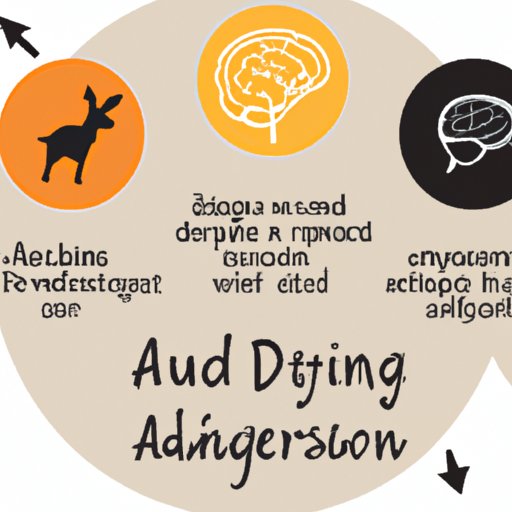
I. Introduction
Attention deficit hyperactivity disorder (ADHD) is a common neurodevelopmental disorder that is often associated with children and adolescents. However, ADHD can carry over into adulthood, and the symptoms can evolve and change over time. This article aims to explore whether or not you can grow out of ADHD, and the importance of understanding this disorder as you age.
II. The Science Behind ADHD and Age: Can You Outgrow It?
ADHD is a neurodevelopmental disorder that affects the brain’s ability to control impulses, behavior, and attention. It is often a genetic condition, and research suggests that differences in the brain’s structure and function can cause ADHD symptoms. Neurodevelopmental disorders include a broad spectrum of conditions that arise from abnormal brain development such as Autism Spectrum Disorder (ASD), Intellectual Disability (ID), and many others (CDC).
There has been a common misconception that ADHD is only prevalent in children and that individuals grow out of it when they reach adulthood. Although some people may outgrow their symptoms, a significant number of individuals continue to experience ADHD symptoms well into adulthood. Despite increased knowledge about this disorder, the progress has been slow to develop effective treatments and lead to social acceptance of people with ADHD.
III. Navigating ADHD in Adulthood: My Journey and Lessons Learned
As someone who has been living with ADHD throughout adulthood, I can attest to the challenges and victories that come with this disorder. One of the most significant barriers I have faced is the stigma surrounding ADHD and the lack of understanding from others. It has taken time, patience, and reflection to learn how to cope and develop the necessary skills to succeed while living with ADHD. Despite the challenges, it is possible to live a fulfilling life with ADHD.

IV. Redefining ADHD in the Context of Aging: A Case for Neurodiversity
Neurodiversity is the idea that neurological differences are natural variations and should be embraced as part of human diversity. ADHD should be understood not as a limitation but as a different way of experiencing the world. Many individuals with ADHD have unique strengths that can lead to innovative ideas and perspectives. A neurodiverse perspective helps create a more inclusive society where everyone is valued and supported.
V. Understanding ADHD Symptoms and Treatment Over Time
ADHD symptoms can evolve over time, and it is essential to understand these changes to manage the disorder effectively. There are two types of ADHD problems, namely inattention and hyperactivity-impulsivity. It can manifest in different ways and can have various degrees of severity. The different types of ADHD include predominantly inattentive, predominantly hyperactive-impulsive, or a combination of both.
Treatment for ADHD may involve medication, therapy, or a combination of both strategies. It is crucial to work with a mental health professional to determine which treatment will be the most effective for you. After receiving adequate treatment, individuals with ADHD have shown improvement in job performance, relationship satisfaction, and overall quality of life.
VI. ADHD Across the Lifespan: How Symptoms Evolve and Change
ADHD symptoms develop in childhood and can continue into adulthood, but they may appear differently. Children with ADHD often have difficulty focusing, controlling their impulses, and staying organized. Adults with ADHD may experience similar challenges but may also struggle with managing their time, following through with tasks, and maintaining employment.
The developmental trajectory of ADHD symptoms may vary, and it is crucial to seek help from a mental health professional to optimize treatment in light of these changes.
VII. The Role of Social Support and Coping Mechanisms in Managing ADHD as You Age
ADHD can be isolating, and building a support system can be essential in managing the disorder. A supportive partner, family members, friends, or ADHD support groups can help to provide understanding and practical support. There are also various coping mechanisms that individuals with ADHD can use to manage their symptoms and achieve success. These may include exercise, meditation, therapy and coaching among others.
VIII. Addressing the Stigma of ADHD in Adulthood: How to Advocate for Yourself and Others
ADHD carries with it a degree of stigma in adulthood, which can negatively impact an individual’s self-esteem, relationships, and employment. Advocating for yourself and others with ADHD is crucial to creating a more supportive and inclusive society. It involves educating others about ADHD, promoting respect for neurodiversity, and pushing for institutional changes that benefit individuals with ADHD.
IX. Conclusion
In conclusion, ADHD is a neurodevelopmental disorder that affects individuals across the lifespan. Although some people may outgrow their symptoms, many individuals with ADHD experience it into adulthood. Understanding ADHD in the context of aging means accepting neurodiversity, recognizing and addressing stigma, and finding effective treatments and coping strategies to manage and even celebrate the unique perspective that ADHD brings.
Don’t forget to seek help from a mental health professional if you or a loved one is struggling with ADHD symptoms.




